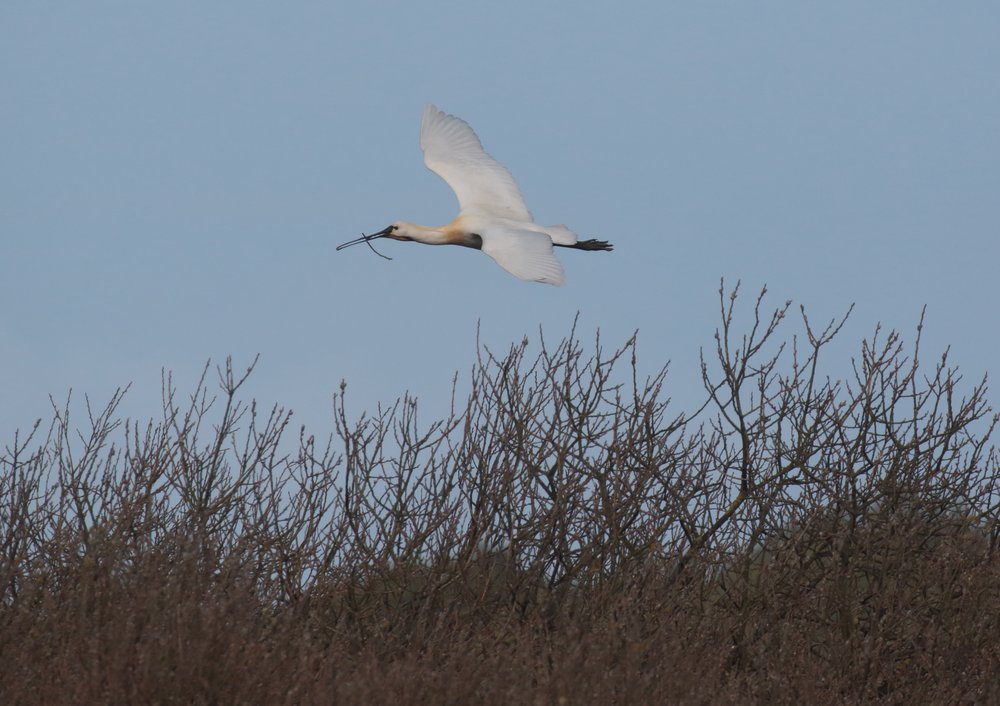Woodland Wonders
An extensive woodland management project led to an unexpected result on a Norfolk farm
When Alice Atkinson undertook an extensive woodland management project on her farm it led to a rare colony of spoonbills setting up home in the trees, as Lee Murphy reports.
Old Rectory Farm is situated on the stunning north Norfolk coast and is home to Alice Atkinson and her family. The farm stretches to around 800 acres and is a mix of arable and grazing, woodland, meadows, and a beef herd.
The farm was originally bought by Alice’s grandparents in the 1930’s. Back then, there was very little woodland at the farm but after returning from World War II her grandfather spent the late 1940’s and 50’s planting trees strategically, alongside his farming business.
Most of these new areas of woodland were originally a mixture of Corsican and Scots Pine but are now full of self-seeded natives as well. In the 1970’s her father continued the tree planting, with more native deciduous trees.
When Alice took over the running of the farm around 10 years ago it was clear to her, as a trained landscaper and garden designer, that the woodland needed significant management. “Much of the woodland needed thinning,” says Alice. “Some areas considerably more than others, where the dense canopy was preventing light coming in - essential for encouraging diverse plant and wildlife.”
In 2019, Alice acquired a government grant and, with support from Sentry, had each wood professionally surveyed and a plan drawn up to enhance the health of all woodland as well as licenses approved to undertake the work.
The area that needed the most dramatic improvement was Northforeland, a pine wood situated next to the Norfolk Wildlife Trust’s Cley and Salthouse Marsh. For many years herons and little egrets have nested in the tops of a few trees in Northforeland so these were carefully fenced off by Alice before the contractors started work.
The work was undertaken in the winter to minimise impact. As a result, light immediately flooded in, most of all in Northforeland where clearings and rides were revealed and which Alice would shortly discover made an ideal environment for the rare spoonbill to nest.
The spoonbill is a large white heron-like species, standing three foot tall with a four foot wingspan. It gets its name from its long bill that has a flat spoon-shaped tip. It is believed there are only eight breeding sites recorded in England.

“Within five weeks after the woodland being completed we noticed spoonbills carrying nesting material into Northforeland,” says Alice. “We had seen spoonbills visit the woodland previously but they had never stayed. Maybe they nested coincidently, but the change to the woodland was dramatic, creating a completely different and healthier environment.”
Old Rectory Farm is located in a tourist hotspot with the north Norfolk coast attracting a high volume of visitors. It has led Alice to install expensive fencing around Northforeland to ensure the spoonbills are left undisturbed.
“We try to maintain private areas of the farm for wildlife and have public footpaths across the land as well. Public access is important, but it is a disaster when people go into areas that are dedicated to wildlife, so should be left undisturbed – something we have to be increasingly aware of with such high visitor numbers.”
Nearby Holkham Estate has an established colony of spoonbills at its nature reserve. in 2010 six pairs nested and produced 10 fledged juveniles. It put Holkham in the record books and at the forefront of a revival for a once much persecuted species. They have now had nearly 500 chicks fledge from the reserve.

Andrew Bloomfield is the warden at Holkham National Nature Reserve and founder of the UK Spoonbill Working Group. “My understanding is that the thinning of the wood created openings in the canopy and small glades which spoonbills need for accessibility. They now have easy access in and out of the wood and a good source of invertebrates and small fish for food in the nearby salt marshes. It’s an ideal location. It may be an unintended consequence of the woodland management, but it’s great to see the species thriving.”
Around a third of Old Rectory Farm is dedicated to wildlife with meadows, woodland and pasture. Alice and her family have always taken their role as custodians of the land seriously. “We place a high priority on balancing nature and farming and have strived to do so for generations. I am currently researching rainwater harvesting systems, continuing to plant trees where we can and extensively planting and replanting hedgerows, taking our hedge management seriously.”
On the success of increasing spoonbill populations in the UK Andrew concluded: “It really does seem like the spoonbill is reaping the benefits of protection and better quality habitat -a definite story of success.”